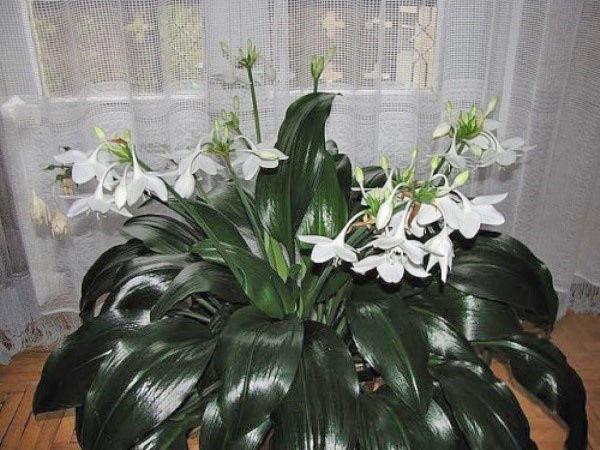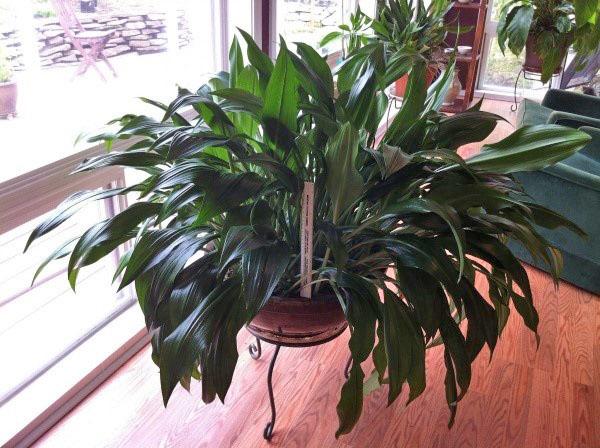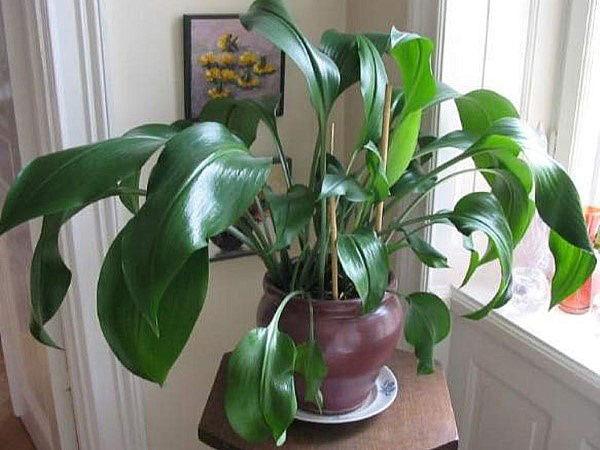Caring for eucharis at home - simple secrets of abundant flowering
 If you like plants with large flowers and have enough free space at home, plant eucharis. Caring for eucharis at home is not at all difficult. In gratitude, the flower will delight you with gorgeous flowering, and twice a year. For its large, white and fragrant flowers hanging in bunches from the top of the peduncle, the plant was nicknamed the Amazonian lily. What is so special about this flower that he loves and what should be considered when growing it?
If you like plants with large flowers and have enough free space at home, plant eucharis. Caring for eucharis at home is not at all difficult. In gratitude, the flower will delight you with gorgeous flowering, and twice a year. For its large, white and fragrant flowers hanging in bunches from the top of the peduncle, the plant was nicknamed the Amazonian lily. What is so special about this flower that he loves and what should be considered when growing it?
Botanical characteristic

It is not inferior to the beauty of eucharis leaves and its flowering, which has practically no equal. It is simply impossible not to see gorgeous flowers. Peduncle up to 70 cm long stands proudly above the deciduous cap. Its top is decorated with large flowers up to 12 cm in diameter, exuding a sweet aroma. At the same time, they begin to open within 2 weeks after the appearance of the peduncle.
The color of eucharis inflorescences is predominantly white, but there are also hybrid varieties with blue and cream inflorescences.
The homeland of the eucharis plant is considered to be the humid tropics of South and Central America. This thermophilic lily also grows wild in Colombia and near the Amazon River. It is not surprising that the flower has taken root with us. It is happily grown in botanical and private winter gardens, as well as simply as a houseplant. In general, this is not difficult if you take into account the origin of the plant and the characteristics of its root system.
Conditions of keeping eucharis
 In order for the leaves to retain their rich color, the indoor eucharis flower should not experience a lack of sunlight. Under natural conditions, it grows in the openwork shade of trees, receiving its share of the sun. In the lily house, it is better to take the east or west windowsill. It will be too dark for the plant on the north window, and inside the room the leaves will begin to brighten and stretch out the petioles. The southern side, on the contrary, is too bright for eucharis - burns will quickly appear on the leaves.
In order for the leaves to retain their rich color, the indoor eucharis flower should not experience a lack of sunlight. Under natural conditions, it grows in the openwork shade of trees, receiving its share of the sun. In the lily house, it is better to take the east or west windowsill. It will be too dark for the plant on the north window, and inside the room the leaves will begin to brighten and stretch out the petioles. The southern side, on the contrary, is too bright for eucharis - burns will quickly appear on the leaves.
Eucharis is one of those plants that you need to "hide" from small children and pets. The leaves contain the poisonous substance lycorin, and even a small amount of the eaten plant causes vomiting.
Like all tropical exotic species, the Amazonian lily is very thermophilic. For active growth and flowering, she needs at least 20 ° of heat. Moreover, these should be stable values, without sharp fluctuations. Temperature differences of "plus-minus" 7 ° and more have a negative effect on flowering. Therefore, even in summer it is advisable to keep eucharis in the house and not to take it out into the garden. But in winter, a slight decrease in temperature to 18 ° C is permissible. During this time, the bulb is in a state of relative dormancy, preparing for the next flowering. Already 10 ° C are critical for eucharis: its leaves begin to die off, and the bulb begins to rot.
Lily rests little - a little over a month.Thanks to this, with proper care of the eucharis, it will bloom twice at home, in spring and autumn. There are times when the lily blooms for the third time, in the middle of winter.
As a native of the tropics, the Amazon lily loves high humidity, but feels quite tolerant in the house. It is enough to spray the foliage on especially hot days, but only outside flowering. Water that gets on flowers leaves ugly brown spots on them. It is best to wipe down the foliage frequently with a damp sponge.
Soil and soil for eucharis
 In its homeland, eucharis grows in a loose substrate, rich in organic matter. As a pot culture, a ready-made store substrate for Amaryllis is suitable for him.
In its homeland, eucharis grows in a loose substrate, rich in organic matter. As a pot culture, a ready-made store substrate for Amaryllis is suitable for him.
You can also make a fertile and light soil yourself by mixing:
- 2 pieces of leafy land;
- 1 part of sand and humus;
- 0.5 part peat.
As a bulbous plant, eucharis needs good drainage to prevent root decay. At the bottom of the pot, it is imperative to pour expanded clay or small pebbles.
 When choosing a flowerpot for a lily, it should be borne in mind that it builds up a decent-sized deciduous rosette. Therefore, it is worth giving preference to heavy ceramic pots that will not tip over under the weight of the plant. However, it is not necessary to use too spacious dishes, otherwise the first flowering will not come soon. The exception is group planting - then a wide bowl is ideal for several bulbs.
When choosing a flowerpot for a lily, it should be borne in mind that it builds up a decent-sized deciduous rosette. Therefore, it is worth giving preference to heavy ceramic pots that will not tip over under the weight of the plant. However, it is not necessary to use too spacious dishes, otherwise the first flowering will not come soon. The exception is group planting - then a wide bowl is ideal for several bulbs.
And if the purpose of planting is not flowering, but reproduction? When asked why eucharis does not give children, many practicing flower growers advise, on the contrary, to plant it in a spacious pot. Say, cramped dishes - stimulates flowering, and wide - reproduction. Try to check.
Home care for eucharis
 Eucharis will not cause special problems, moreover, excessive concern will only harm him.
Eucharis will not cause special problems, moreover, excessive concern will only harm him.
In order for the bush to grow new leaves and bloom "on schedule" twice a year, it only needs:
- Moderate watering. During the rest period, you need to wait for the soil in the pot to dry out to half the volume. The rest of the time, the plant should be watered only when the soil dries out by 1/3 (about 4-5 cm). Excess moisture is detrimental to the bulb and is fraught with rotting.
- Timely feeding. As an additional nutrition, you can use any mineral complex for decorative flowering or bulbous plants. However, you need to feed the flower only during the flowering period and no more than 2 times a month.
 Separately, it should be noted that caring for eucharis at home should include the opportunity to give the flower a rest. The dormant period of the lily is not pronounced and short. This means that it does not shed foliage, but simply stops its development for a period of just over a month. At this time, it is advisable to take the flower to a cooler place and reduce watering. It is better not to touch the flower stalks until they themselves dry up, but only then cut them off. They give nutrients to the bulb.
Separately, it should be noted that caring for eucharis at home should include the opportunity to give the flower a rest. The dormant period of the lily is not pronounced and short. This means that it does not shed foliage, but simply stops its development for a period of just over a month. At this time, it is advisable to take the flower to a cooler place and reduce watering. It is better not to touch the flower stalks until they themselves dry up, but only then cut them off. They give nutrients to the bulb.
How to understand that eucharis has a period of rest? After the last flower opens and the lily fades, it "freezes" and stops growing. And as soon as young leaves or children appear, it means that the eucharis has already rested and is ready to develop further.
Features of eucharis transplant
 Like all plants, the Amazonian lily grows over time and becomes overgrown with daughter bulbs. Naturally, such a "family" becomes cramped in the pot and requires a transplant. It is better to do this after the eucharis has faded, or in the spring, combining with reproduction. It is worth dividing the bulbs carefully, trying to keep the earthen lump intact as much as possible. So the risk of damage to the fleshy roots will be minimal. The smallest babies should be left on the mother's bulb, otherwise it may stop blooming for a while until new offspring grows.
Like all plants, the Amazonian lily grows over time and becomes overgrown with daughter bulbs. Naturally, such a "family" becomes cramped in the pot and requires a transplant. It is better to do this after the eucharis has faded, or in the spring, combining with reproduction. It is worth dividing the bulbs carefully, trying to keep the earthen lump intact as much as possible. So the risk of damage to the fleshy roots will be minimal. The smallest babies should be left on the mother's bulb, otherwise it may stop blooming for a while until new offspring grows.
When caring for an indoor eucharis flower, transplanting should not be done too often.This is especially true when the bulb grows alone and does not want to multiply.
Only when she acquires many children does the plant begin to bloom fully, besides, the tightness only stimulates flowering. In one pot eucharis can easily live for three years.
 There are different opinions regarding the depth to plant eucharis. Some growers leave the top of the bulb above the ground, like hippeastrum. However, after planting bulbs with baby crumbs, the offspring are completely covered with soil. But this does not prevent them from growing further. So you can safely fall asleep eucharis, immersing the entire bulb in the ground completely. All that is needed, it will "push" to the surface itself. But if the bulbs do not have their own leaves, it is better to leave their top above the soil.
There are different opinions regarding the depth to plant eucharis. Some growers leave the top of the bulb above the ground, like hippeastrum. However, after planting bulbs with baby crumbs, the offspring are completely covered with soil. But this does not prevent them from growing further. So you can safely fall asleep eucharis, immersing the entire bulb in the ground completely. All that is needed, it will "push" to the surface itself. But if the bulbs do not have their own leaves, it is better to leave their top above the soil.
Eucharis breeding methods
 At home, the Amazonian lily reproduces mainly by division. When an adult bulb forms many children, and they grow at least a few of their own leaves, you can divide the bush. Each grown child, from 5 cm in size, should be separated and planted in a separate, small, pot. A 10 cm container is enough for one plant.
At home, the Amazonian lily reproduces mainly by division. When an adult bulb forms many children, and they grow at least a few of their own leaves, you can divide the bush. Each grown child, from 5 cm in size, should be separated and planted in a separate, small, pot. A 10 cm container is enough for one plant.
If you want to speed up flowering, you can plant several bulbs in one pot. Eucharis blooms better and more often in cramped conditions, but then the flowerpot should be wider.
 Reproduction of eucharis by seeds is another way to get new plants. However, in indoor floriculture, it is almost never used. Seeds do not germinate well, besides, flowering will have to wait 4-5 years.
Reproduction of eucharis by seeds is another way to get new plants. However, in indoor floriculture, it is almost never used. Seeds do not germinate well, besides, flowering will have to wait 4-5 years.
Problems that can be faced when growing eucharis
 The Amazon lily is not the most favorite flower among pests, but sometimes the turn comes to her.
The Amazon lily is not the most favorite flower among pests, but sometimes the turn comes to her.
If the conditions of detention are not followed or there are infected flowers nearby, eucharis may suffer from:
- thrips (light spots on the top of the leaves and their darkening);
- spider mite (silvery cobweb on the back of the leaf, blanching and further leaf fall);
- mealybug (white flakes on the plant).
Special preparations-insecticides (Actellik, Decis) will help to get rid of uninvited guests.
In addition, lily is not immune to various fungi. Among the diseases of eucharis, the most common are:
- Gray rot. The leaves become soft and lethargic, darken at the edges and become covered with a gray bloom. Reason: excess moisture at low temperatures. What to do: cut off all diseased areas, treat with copper-containing preparations, ventilate more often.
- Stagonosporosis. Red oval spots appear on the leaves and wither. Peduncles become crooked, and the bulb rots. Reason: excess moisture, sudden changes in temperature. What to do: remove all damaged leaves, treat with copper sulfate.
Also, if the eucharis bulb rots, this may be the result of excessive watering. Lily does not tolerate waterlogging and will better tolerate a lack of water than an excess of it. It is urgent to get the bulb, remove the rotten parts and treat with a fungicide. It is better to replace the land and continue to reduce the frequency of watering in order to prevent water stagnation again.
But, be that as it may, do not let possible problems and failures stop you before the goal of getting a room lily with wide leaves. A chic decorative look of a deciduous rosette, even outside of flowering, will decorate the room. And when delicate buds appear, all doubts will be dispelled, and you will understand - this flower is really worth growing!